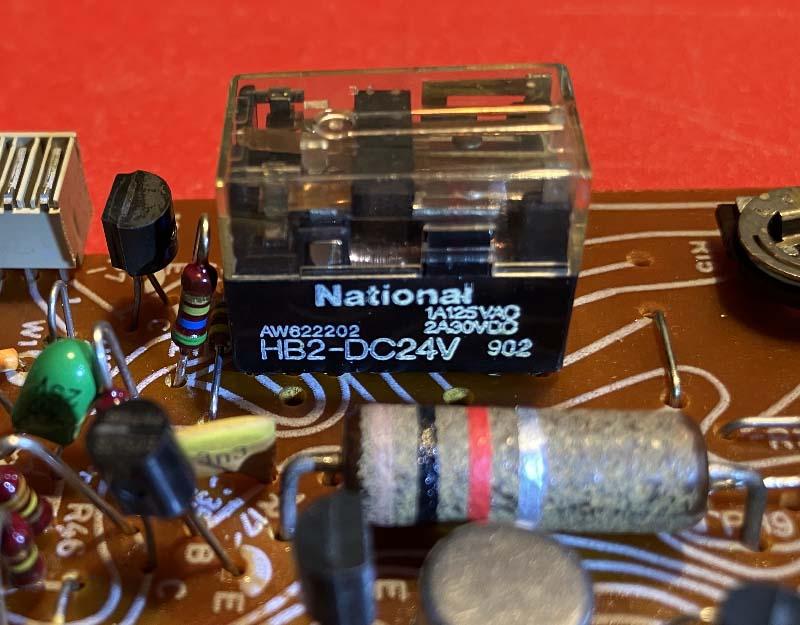- This topic has 19 replies, 4 voices, and was last updated 2 years, 2 months ago by
matador.
- AuthorPosts
- 2 April 2022 at 04:38 #33779
Hi All,
i am working on a BG4002 with speed fluctuations at 33 & 45 rpm !
Martin pointed the finger straight to the DC platter motor and its worn bearings.
fair point !!
After comparing my spare motor with the sick motor I could instantly
feel the difference by finger-spinning its axle .
so far so good – I swapped over the two motors but now I can not sufficiently slowing
down the spare motor ?
new 25-turn trimmer pots – 33 & 45 – were fitted and the speed-change relay replaced by a modern version.
I asked if by any chance the speed controlling IC 1003C may be faulty but was ruled
out as a likely cause ?
i have to mention that all inputs at the speed controlling IC 1003C show 1 V higher than specified in the circuit diagram !!
as no other suspicious component was found would the spare motor also be in need of new bearings I wonder ??
if indeed its bearings are also worn would that case not rather having a “breaking effect” in the motor with higher friction to be expected and running slower and with speed fluctuations ?
anyone care to share some advice ???
thank you
ALF
2 April 2022 at 05:34 #33780Worn bearings would not cause a motor to run fast. I would approach diagnosing this in this way.
- Determine if the speed is fast for both 33 and 45.
- Determine if the speed is faster for 45 to the same extent as it is for 33.
- Determine what specific speed range for 33 and 45 you can adjust over.
- Determine whether the speed is steady even though fast.
From the answers to the above, one can pin down the area of the system causing the problem. Feel free to post these and I’ll give you my diagnosis.
2 April 2022 at 05:34 #33782Yup need to do some measurements instead of using your ear to answer my questions. Download a turntable App for your phone such as RPM and come back with answers to 3 and 4.
2 April 2022 at 07:22 #33781My thoughts exactly, the motor should not run faster with a worn bearing !
running faster is not so much the problem because there are trimmer pots to adjust.
the issue is that I can not regulate sufficiently down the 33rpm speed – I can do that with the 45rpm speed though.
i only have one 45 single and can adjust that by ear as I know Bonos voice. To my ears
the speed sounds correct and steady.
the same applies to the 33rpm setting apart from the regulating down issue, which I seem unable to do…it is just a tick too fast, which I can see on a strobo disc and hear – I know McCartneys voice.
both trimmer pots are 5kOhm 25-turn Bourne trimmers.
Both 2R2 and 1R15 are on the edge of their range but it is still too fast spinning.
not sure if that is helping a diagnose ?
ALF
3 April 2022 at 04:50 #33784Hi alls,
Now the OP problem is solved I’d like to add my case.
I’ have two BG4002, one (A) is spinning fine the other (B) not so much. The second (B) was wowing mostly in 45 rpm but now it wows also in 33 rpm. Note that it may be that wowing is more noticeable in 45 than 33 and was ever there.
I know I need to reinfuse the bearings as a starting point but frankly, I’m afraid of this step. So I tried another way.
I swapped parts between A and B: belt, motor, keyboard. B is still wowing.
I did’nt swap the main board because the BG are different types and on the B, there is one of those round flat orange capacitor that is not present on the A board. So there comes my questions:
- Can those old trimmers be responsible for fluctuations? I beleive they can cause imprecise adjustment but once they’re set, they’re set, right?
- what can, as th OP asked, cause fluctuations when the usual suspects (belt and motor) have been ruled out.
Thank you for your advices.
3 April 2022 at 06:22 #33785You most likely need to replace the speed switch relay. There are modern replacement kits available on eBay or Beolover’s site.
3 April 2022 at 06:33 #33786That’s a fast reply! Thanks.
Ok, I will look a this.
Just for my own knowledge: how is that?
I mean a relay is contact or no contact, haw can he create variations in speed?
Components like capacitors, resistors etc may have their characteristics evolving with heat, time… but a relay, it sticks or it don’t, right? How could he make the speed unstable?Thanks again.
3 April 2022 at 08:26 #33783I guess I don’t have to answer Q3 &Q4 ………
not something I suspected, but the shop sold me two 2 KOhm trimmers instead of
5 kOhm trimmers ??
too much trust is not often rewarded – now both speeds can be set and are in fact
set now.
The W/F is very minimal and will improve further after the DC motor has new bearings.ALF
3 April 2022 at 10:50 #33787A relay’s contacts can corrode over the decades especially when not hermetically sealed. This introduces a variable resistance which causes the speed variation. One can affect a temporary fix by carefully cleaning the contacts since the cover is removable; however, this is only a temporary fix and its very easy to bend the thin contact supports making it worse.
4 April 2022 at 05:42 #33788That makes sense, thanks for the explanation.
The relay are quite difficult to source I believe.
Just to rule out that part and be sure, would it be possible to short some pins from the relay and check for speed stability.4 April 2022 at 05:53 #33789Apply deoxit to the contacts wait 10/15 min. clean with alcohol, I use thin paper strips doing it
4 April 2022 at 09:09 #33790The OEM relay is not available, but the replacement kits are readily on eBay depending on which relay you have. This is a DPDT relay that defaults to the 33 speed when unpowered. I would only jumper that side or remove it if you want to test 45 as well. In any case, I would always replace it at this point as any cleaning fix is only temporary and the part is cheap enough.
5 April 2022 at 01:07 #33791Will do that, Thank you.
6 April 2022 at 01:18 #33792Hi, me again,
I’ve taken out the main board just to see. The two speed trimmers where black of dirtiness like burned. I’ve cleaned them with contact cleaner. It make things a little better but not good still. Then I’ve looked at the relay: it means nothing but to looks quite clean and new.
Anyway, what concernes me is that the relay doesn’t look like those I’m use to see on other boards, it looks smaller and not consistent with the footprint of the usual replacement relay.
PS: I know whatever I do to play the clock I’ll need to change the relay, the trimmers and certainly other things, but I would fancy temporary fixes that also would make me understand how all this work.
 6 April 2022 at 04:28 #33793
6 April 2022 at 04:28 #33793That relay is the stock one for 4002’s that have DC motors. Simply get the replacement kit for that type. If you want to experiment swap it with the muting relay as that one may be in better shape since DC does not flow thru it’s contacts.
6 April 2022 at 06:24 #33794Ok, I can see now, National or Siemens, you avoid me a mistake in the rush!
– and of course it’s the one I need the most expensive 😀 –
14 April 2022 at 05:31 #33796I know the muting board had the additional pattern so it could be the same for the main board. It is easy enough for you to check. In any case the newer sealed ones are your long term solution.
14 April 2022 at 08:08 #33795Hi Mark, Me again!
It happen I have two replacement relay already: some times ago I edited the BG4000 paperwork for a forum member and he gifted me in return with various part including two relays!
They seems to have the large footprint (Siemens) and my deck have National relays.
I remembrer they were a lot of holes on the PCB and I wonder if the PCB still have the traces to use the old relay or was the PCB completely redesigned?Do you know that? Thanks.
13 June 2022 at 03:06 #33797Hi All,
Just a brief summary since I started that post regarding speed issues on my 4002 table.
replaced were the old speed trimmers with 25-turn Bourns trimmer, a modern speed-switching relay was installed and finally the DC platter motor received new bearing, which in the end settled the issue !!
all playing nicely again ? or should I say “beolovely” ?!
ALF
2 December 2022 at 10:07 #33798A relay’s contacts can corrode over the decades especially when not hermetically sealed. This introduces a variable resistance which causes the speed variation. One can affect a temporary fix by carefully cleaning the contacts since the cover is removable; however, this is only a temporary fix and its very easy to bend the thin contact supports making it worse.
Hi Mark and everybody,
I’m feed up with all those album reissue at 45 rpm but when I found one I really wanted, I thought I must have something done about my 45′ speed problem.
Still not brave enough to replace the relay I decide to clean it with a strip of paper soaked in electric contact cleaner like Dillen taught us all.
Speed problem solved for now! Thank you everybody and especially Mark and Martin.
- AuthorPosts
- You must be logged in to reply to this topic.





